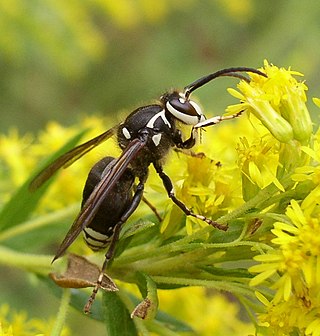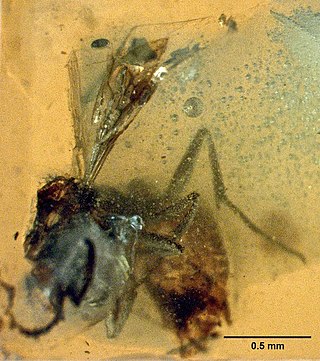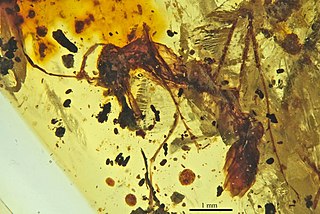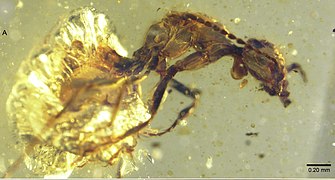
Vespoidea is a superfamily of wasps in the order Hymenoptera. Vespoidea includes wasps with a large variety of lifestyles including eusocial, social, and solitary habits, predators, scavengers, parasitoids, and some herbivores.

Sphecomyrminae is an extinct subfamily of ants in family Formicidae known from a series of Cretaceous fossils found in North America, Europe, and Asia. Sphecomyrminae contains eight genera, divided into two tribes Sphecomyrmini and Zigrasimeciini. The tribe Sphecomyrmini contains the six genera Armania, Cretomyrma, Gerontoformica, Orapia, Pseudarmania and Sphecomyrma; while Zigrasimeciini contains Boltonimecia and Zigrasimecia. A number of taxa have been removed from the subfamily and placed either in other subfamilies or are now treated as incertae sedis in Formicidae.

Haidomyrmecinae, occasionally called hell ants, are an extinct subfamily of ants (Formicidae) known from Cretaceous fossils found in ambers of North America, Europe, and Asia, spanning the late Albian to Campanian, around 100 to 79 million years ago. The subfamily was first proposed in 2003, but had been subsequently treated as the tribe Haidomyrmecini and placed in the extinct ant subfamily Sphecomyrminae. Reevaluation of the Haidomyrmecini in 2020 lead to the elevation of the group back to subfamily. The family contains the nine genera and 13 species.

Brownimecia is an extinct genus of ants, the only genus in the tribe Brownimeciini and subfamily Brownimeciinae of the Formicidae. Fossils of the identified species, Brownimecia clavata and Brownimecia inconspicua, are known from the Middle Cretaceous to Late Cretaceous of North America. The genus is one of several ants described from Middle Cretaceous ambers of New Jersey. Brownimecia was initially placed in the subfamily Ponerinae, until it was transferred to its own subfamily in 2003; it can be distinguished from other ants due to its unusual sickle-like mandibles and other morphological features that makes this ant unique among the Formicidae. B. clavata is also small, measuring 3.43 millimetres (0.135 in), and a stinger is present in almost all of the specimens collected. The morphology of the mandibles suggest a high level of feeding specialization.

Zigrasimecia is an extinct genus of ants which existed in the Cretaceous period approximately 98 million years ago. The first specimens were collected from Burmese amber in Kachin State, 100 kilometres (62 mi) west of Myitkyina town in Myanmar. In 2013, palaeoentomologists Phillip Barden and David Grimaldi published a paper describing and naming Zigrasimecia tonsora. They described a dealate female with unusual features, notably the highly specialized mandibles. Other features include large ocelli, short scapes, 12 antennomeres, small eyes, and a clypeal margin that has a row of peg-like denticles. The genus Zigrasimecia was originally incertae sedis within Formicidae until a second species, Zigrasimecia ferox, was described in 2014, leading to its placement in the subfamily Sphecomyrminae. Later, it was considered to belong to the distinct subfamily Zigrasimeciinae.

Haidomyrmodes is an extinct genus of ant in the formicid subfamily Haidomyrmecinae, and is one of only nine genera placed in the subfamily Haidomyrmecinae. The genus contains a single described species, Haidomyrmodes mammuthus. Haidomyrmodes is known from several Middle Cretaceous fossils which have been found in Europe.

Haidoterminus is an extinct genus of ant in the Formicidae subfamily Haidomyrmecinae, and is one of only nine genera placed in this subfamily. The genus contains a single described species Haidoterminus cippus and is known from one Late Cretaceous fossil which has been found in North America.

Haidomyrmex is an extinct genus of ants in the formicid subfamily Haidomyrmecinae, and is one of nine genera placed in the subfamily Haidomyrmecinae. The genus contains three described species Haidomyrmex cerberus, Haidomyrmex scimitarus, and Haidomyrmex zigrasi. All three are known from single Late Cretaceous fossils which have been found in Asia. H. cerberus is the type species and Haidomyrmex the type genus for the subfamily Haidomyrmecinae.

Burmomyrma is an extinct genus of aculeate hymenopteran, suggested to be an ant. The genus contains a single described species, Burmomyrma rossi. Burmomyrma is known from a single Middle Cretaceous fossil which was found in Asia.
Armaniinae is subfamily of extinct ant-like hymenopterans known from a series of Cretaceous fossils found in Asia and Africa. It is usually treated as one of the stem-group subfamilies in family Formicidae, although some myrmecologists treat it as a distinct family. A 2007 study analysing petiole and antenna morphology led to the proposal that at least some of the armaniid genera be placed in Sphecomyrminae, although others are unconvinced by the arguments and retain Armaniinae. The subfamily contains seven genera with fourteen described species.

Myanmyrma is an extinct genus of ants not placed into any Formicidae subfamily. Fossils of the single known species, Myanmyrma gracilis, are known from the Middle Cretaceous of Asia. The genus is one of several ants described from Middle Cretaceous ambers of Myanmar.
Cananeuretus is an extinct genus of ant in the Formicidae subfamily Aneuretinae, and is one of two Cretaceous genera of the subfamily. The genus contains a single described species Cananeuretus occidentalis and is known from one Late Cretaceous fossil which has been found in North America.

Gerontoformica is an extinct genus of stem-group ants. The genus contains thirteen described species known from Late Cretaceous fossils found in Asia and Europe. The species were described between 2004 and 2016, with a number of the species formerly being placed into the junior synonym genus Sphecomyrmodes.

Camelomecia is an extinct genus of stem-group ants not placed into any Formicidae subfamily. Fossils of the single known species, Camelomecia janovitzi, are known from the Middle Cretaceous of Asia. The genus is one of several ants described from Middle Cretaceous ambers of Myanmar.

Baikuris is an extinct genus of ant in the Formicidae subfamily Sphecomyrminae, and is currently placed in the tribe Sphecomyrmini. The genus contains four described species: the type species Baikuris mandibularis, along with Baikuris casei, Baikuris maximus, Baikuris mirabilis, B. ocellantis.

Ceratomyrmex is an extinct genus of ant in the Formicidae subfamily Haidomyrmecinae. The genus contains a single described species Ceratomyrmex ellenbergeri and is known from several Late Cretaceous fossils which have been found in Asia.

Linguamyrmex is an extinct genus of ant in the formicid subfamily Haidomyrmecinae, and is one of only nine genera placed in the subfamily Haidomyrmecinae. The genus contains three described species, Linguamyrmex brevicornis, Linguamyrmex rhinocerus, and the type species Linguamyrmex vladi all known from Late Cretaceous fossils found in Asia.

Boltonimecia is an extinct genus of ant in the formicid subfamily Zigrasimeciinae. The genus contains a single described species, Boltonimecia canadensis, and is known from a single Late Cretaceous fossil which was found in Canada. The type species was originally described as a species of the extinct genus Sphecomyrma under the combination Sphecomyrma canadensis.
Jouault, Corentin; Rosse-Guillevic, Simon. "A new genus of praeaulacid wasp from the mid-Cretaceous Kachin amber (Myanmar)". Annales de Paléontologie. 109 (1): 102599. doi:10.1016/j.annpal.2023.102599.




















